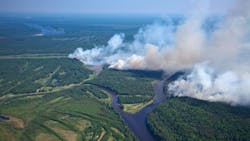SRP-ASU Collaboration Gauges Benefits of Forest Restoration
SRP and Arizona State University have developed a new approach for estimating the water benefits of forest thinning treatments by creating a model that is being recognized as a leading-edge method for analyzing forest thinning’s impacts on water.
After a wildfire, rainfall washes ash and debris into rivers and reservoirs. The large amount of material that washes into SRP’s reservoirs reduces the system’s water storage capacity and can damage water infrastructure downstream such as dams and water treatment plants.
SRP and ASU piloted an effort in the Kaibab National Forest that determined forest thinning on about 3,400 acres would generate a benefit of approximately 230 acre-feet, or nearly 75 million gallons, of water during the first year. One acre-foot of water can provide water for three Arizona families for one year.
Also, SRP and ASU are modeling projects in the East Verde River and East Clear Creek watersheds, which provide water to the Town of Payson and are areas at high risk for catastrophic wildfire. Results from that investigation in the Coconino National Forest are expected later this year.
The researchers created a high-resolution map of the watershed – one that accounts for trees along with their height, size, and species using light detection and ranging (LiDAR) survey and high-resolution photography of the land. The LiDAR, combined with other image data, generated a precise, three-dimensional surface of the watershed.
SRP worked with Professor Enrique Vivoni, Director of the Center for Hydrologic Innovations at ASU, and graduate students and postdoctoral scholars from the center to combine the LiDAR results with other publicly available datasets to create a model of a thinning project area.
“The SRP-ASU innovative water model is applying research to real-world projects to help us understand the watershed benefits of forest thinning. This collaboration has proven to be invaluable as we continue to find ways to ensure water reliability during a record drought and shortages of other sources of water such as the Colorado River,” said Elvy Barton, SRP Manager of Water and Forest Sustainability.
SRP chooses forest thinning projects to fund based on several factors, including potential water benefits, reducing wildfire risk and protecting vital infrastructure and communities. The utility company works with the U.S. Forest Service and the Arizona Department of Forestry and Fire Management to collaboratively choose which forest thinning projects to focus on.
“Arizona is at a crossroads in terms of our water supply portfolio. Applied innovation projects, such as this effort in forest health and water resilience, translate research into actions for the benefit of our renewable water supplies. Not only does our work with SRP set the stage for regional impacts, it is also a successful model for how universities can collaborate effectively with water agencies and utilities,” said Vivoni.
This research, conducted by the ASU Center for Hydrologic Innovation, is part of the Arizona Water Innovation Initiative. The Arizona Water Innovation Initiative is a statewide project led by the Julie Ann Wrigley Global Futures Laboratory in collaboration with Ira A. Fulton Schools of Engineering. Through this initiative, ASU works with industrial, municipal, agricultural, tribal and international partners to rapidly accelerate and deploy new approaches and technology for water conservation, augmentation, desalination, efficiency, infrastructure and reuse.
SRP manages the water supply for much of the Valley – most of which comes from 8.3 million acres of land in northern Arizona. Snowfall and rain provide the water that travels through the watershed into SRP reservoirs, which is then delivered to 2.5 million homes and businesses in the Phoenix Metropolitan area via an extensive network of canals.
About the Author
T&D World Staff
Content Team
Nikki Chandler
Group Editorial Director, Energy
[email protected]
Jeff Postelwait
Managing Editor
[email protected]
Christina Marsh
Senior Editor
[email protected]
Ryan Baker
Associate Editor
[email protected]
Amy Fischbach
Electric Utility Operations
[email protected]
Rich Maxwell
Community Editor
[email protected]
Gene Wolf
Technical Editor
[email protected]
